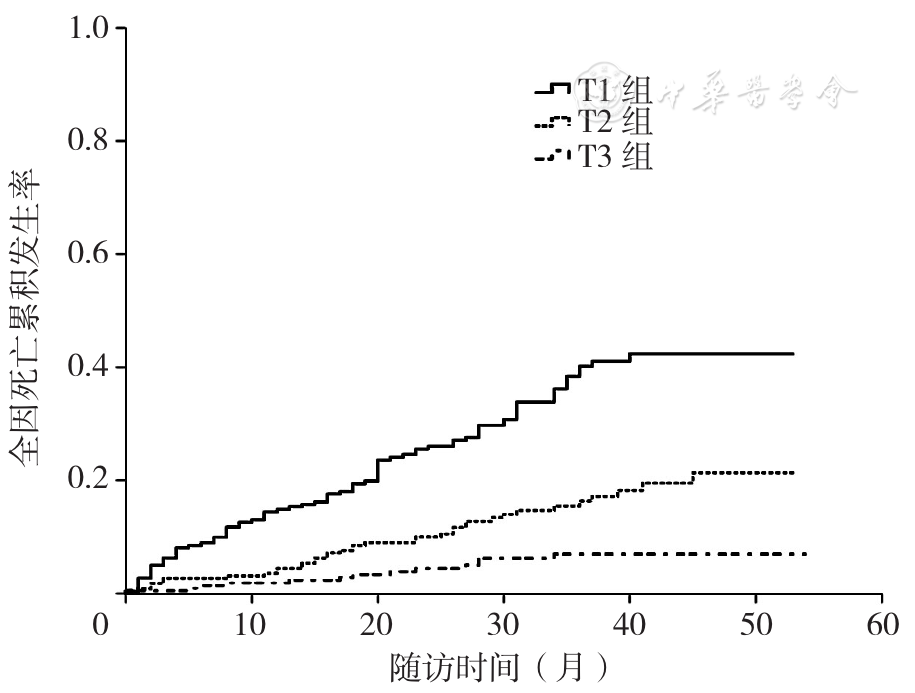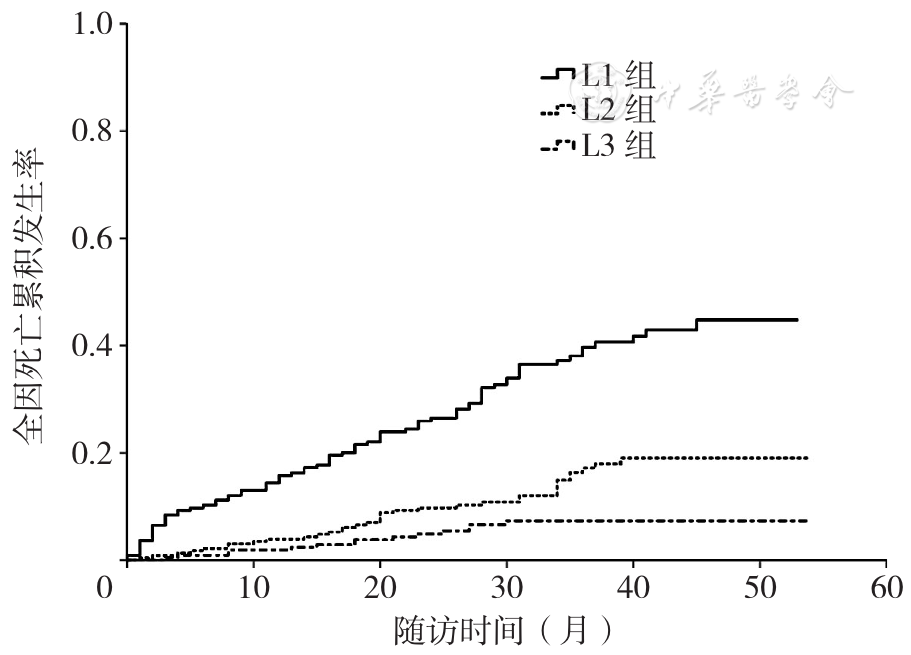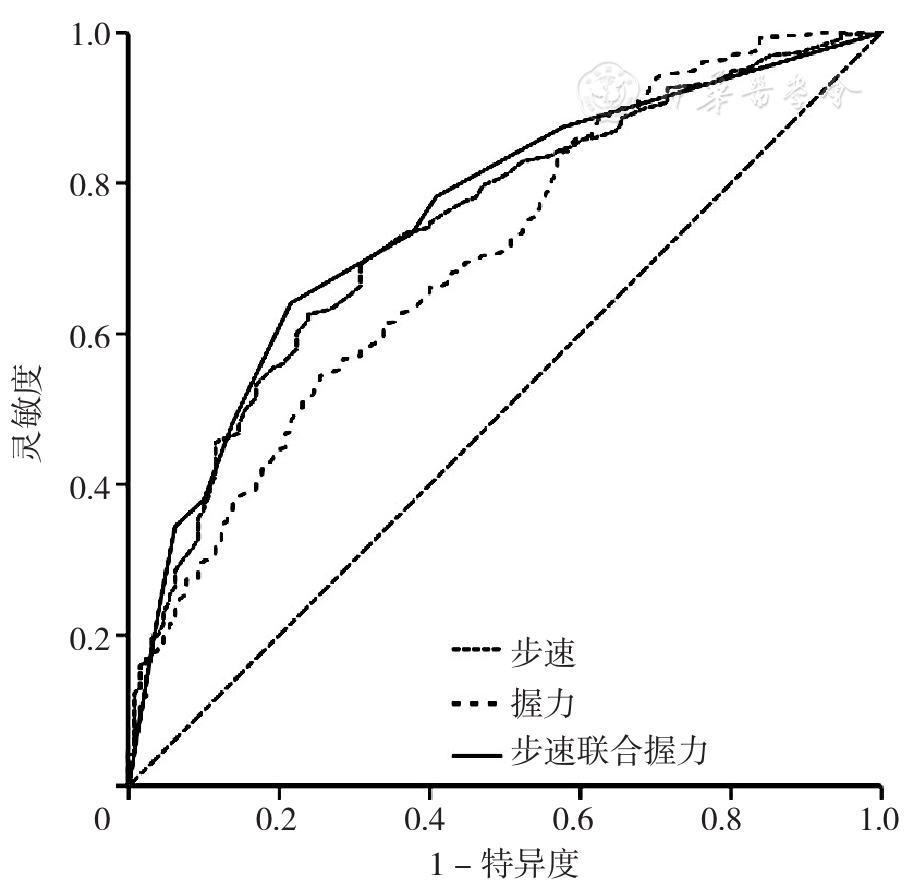中国全科医学 ›› 2022, Vol. 25 ›› Issue (32): 4010-4017.DOI: 10.12114/j.issn.1007-9572.2022.0355
所属专题: 跌倒最新文章合辑; 老年问题最新文章合辑
收稿日期:2022-03-26
修回日期:2022-07-26
出版日期:2022-11-15
发布日期:2022-08-04
通讯作者:
王青
基金资助:
YANG Hui, CUI Yunjing, ZHANG Shaojing, WANG Lijun, WANG Qing*( )
)
Received:2022-03-26
Revised:2022-07-26
Published:2022-11-15
Online:2022-08-04
Contact:
WANG Qing
About author:摘要: 背景 步速和握力是反映身体机能的简单测量指标,均与老年人不良结局相关。目前将步速和握力联合预测住院老年患者不良结局的研究较少。 目的 探讨步速和握力与住院老年患者不良结局的关系。 方法 采用队列研究方法,选取2015年8月至2018年12月在首都医科大学附属复兴医院老年科住院的年龄≥65岁患者,采用6米步行试验计算步速,电子读表式握力计测量握力。依据步速三分位数将患者分为T1、T2、T3组,其中T1组步速≤0.6 m/s,T2组步速>0.6~0.8 m/s,T3组步速>0.8 m/s。依据握力三分位数将患者分为L1、L2、L3组,其中L1组握力:男性≤21.6 kg、女性≤14.6 kg,L2组握力:21.6 kg<男性≤28.2 kg、14.6 kg<女性≤19.4 kg,L3组:男性>28.2 kg、女性>19.4 kg。以电话方式进行随访,患者出院后每3个月开展1次,1年后每半年开展1次。随访截至2019-12-31。记录患者全因死亡及跌倒的发生情况。采用Kaplan-Meier法绘制生存曲线,Cox回归分析探究步速与握力对患者全因死亡及跌倒的影响,受试者工作特征(ROC)曲线比较步速和握力单独及联合对老年患者全因死亡及跌倒的预测效果。 结果 685例患者中失访29例(4.2%),最终收集完整资料共656例。随访期间共130例(19.8%)患者发生全因死亡,147例(22.4%)患者发生跌倒。T1、T2、T3组分别有222、225、209例患者,L1、L2、L3组分别有215、229、212例患者。Log-rank检验结果显示,T1、T2、T3组全因死亡、跌倒累积发生率的生存曲线比较,差异有统计学意义(P<0.01);L1、L2、L3组全因死亡、跌倒累积发生率的生存曲线比较,差异有统计学意义(P≤0.01)。多因素Cox回归分析结果显示,在调整混杂因素后,与T3组、L3组组合患者相比,T1组、L1组组合与T1组、L2组组合患者全因死亡发生风险增加〔HR=3.29,95%CI(1.13,9.55);HR=3.09,95%CI(1.08,8.85);P均<0.05〕,T1组、L1组组合患者跌倒发生风险增加〔HR=1.92,95%CI(1.13,4.27),P<0.05〕。通过Logistic回归分析计算步速、握力联合诊断模型预测概率,并绘制ROC曲线,步速联合握力预测住院老年患者全因死亡、跌倒的ROC曲线下面积(AUC)分别为0.756〔95%CI(0.710,0.801)〕、0.700〔95%CI(0.659,0.741)〕。 结论 在住院老年患者中,步速和握力联合较步速和握力单独能够更好地预测全因死亡及跌倒发生风险,有助于优化老年人的健康管理。
| 项目 | 死亡患者(n=130) | 非死亡患者(n=526) | 检验统计量值 | P值 | |
|---|---|---|---|---|---|
| 年龄(岁) | 87.3±5.0 | 82.5±6.0 | -8.094 | <0.001 | |
| 性别(男/女) | 86/44 | 313/213 | 1.933b | 0.164 | |
| BMI(kg/m2) | 23.0±4.0 | 24.1±3.6 | 3.709a | 0.002 | |
| 步速〔M(P25,P75),m/s〕 | 0.5(0.3,0.6) | 0.7(0.5,1.0) | -8.570 | <0.001 | |
| 握力〔M(P25,P75),kg〕 | |||||
| 男性 | 19.6(13.7,24.5) | 26.3(21.7,30.9) | -7.601 | <0.001 | |
| 女性 | 12.4(7.4,18.4) | 17.3(14.4,20.9) | -4.291 | <0.001 | |
| 合并疾病〔n(%)〕 | |||||
| 高血压 | 110(84.6) | 418(79.5) | 1.759b | 0.185 | |
| 冠心病 | 61(46.9) | 189(35.9) | 5.399b | 0.021 | |
| 脑卒中 | 77(59.2) | 247(47.0) | 6.281b | 0.012 | |
| 糖尿病 | 55(42.3) | 207(39.4) | 0.379b | 0.538 | |
| 慢性肾脏病 | 51(39.3) | 114(21.7) | 20.091b | <0.001 | |
| 慢性阻塞性肺疾病 | 37(28.5) | 110(20.9) | 3.416b | 0.065 | |
| CCI〔M(P25,P75)〕 | 8.0(7.0,10.0) | 7.0(6.0,9.0) | -6.226 | <0.001 | |
| 营养不良(风险)〔n(%)〕 | 62(47.7) | 151(28.7) | 17.135b | <0.001 | |
| 日常生活活动能力下降〔n(%)〕 | 107(82.3) | 236(44.9) | 58.571b | <0.001 | |
| 认知功能障碍〔n(%)〕 | 52(40.0) | 89(16.9) | 32.906b | <0.001 | |
| 多重用药〔n(%)〕 | 62(47.7) | 206(39.2) | 3.138b | 0.076 | |
| 血红蛋白(g/L) | 116.1±18.2 | 127.3±17.4 | 6.476a | <0.001 | |
| eGFR〔ml·min-1·1.73(m2)-1〕 | 72.3±32.1 | 79.8±24.3 | -3.561a | <0.001 | |
表1 死亡与非死亡患者临床资料比较
Table 1 Comparison of clinical data between the deceased and survived patients
| 项目 | 死亡患者(n=130) | 非死亡患者(n=526) | 检验统计量值 | P值 | |
|---|---|---|---|---|---|
| 年龄(岁) | 87.3±5.0 | 82.5±6.0 | -8.094 | <0.001 | |
| 性别(男/女) | 86/44 | 313/213 | 1.933b | 0.164 | |
| BMI(kg/m2) | 23.0±4.0 | 24.1±3.6 | 3.709a | 0.002 | |
| 步速〔M(P25,P75),m/s〕 | 0.5(0.3,0.6) | 0.7(0.5,1.0) | -8.570 | <0.001 | |
| 握力〔M(P25,P75),kg〕 | |||||
| 男性 | 19.6(13.7,24.5) | 26.3(21.7,30.9) | -7.601 | <0.001 | |
| 女性 | 12.4(7.4,18.4) | 17.3(14.4,20.9) | -4.291 | <0.001 | |
| 合并疾病〔n(%)〕 | |||||
| 高血压 | 110(84.6) | 418(79.5) | 1.759b | 0.185 | |
| 冠心病 | 61(46.9) | 189(35.9) | 5.399b | 0.021 | |
| 脑卒中 | 77(59.2) | 247(47.0) | 6.281b | 0.012 | |
| 糖尿病 | 55(42.3) | 207(39.4) | 0.379b | 0.538 | |
| 慢性肾脏病 | 51(39.3) | 114(21.7) | 20.091b | <0.001 | |
| 慢性阻塞性肺疾病 | 37(28.5) | 110(20.9) | 3.416b | 0.065 | |
| CCI〔M(P25,P75)〕 | 8.0(7.0,10.0) | 7.0(6.0,9.0) | -6.226 | <0.001 | |
| 营养不良(风险)〔n(%)〕 | 62(47.7) | 151(28.7) | 17.135b | <0.001 | |
| 日常生活活动能力下降〔n(%)〕 | 107(82.3) | 236(44.9) | 58.571b | <0.001 | |
| 认知功能障碍〔n(%)〕 | 52(40.0) | 89(16.9) | 32.906b | <0.001 | |
| 多重用药〔n(%)〕 | 62(47.7) | 206(39.2) | 3.138b | 0.076 | |
| 血红蛋白(g/L) | 116.1±18.2 | 127.3±17.4 | 6.476a | <0.001 | |
| eGFR〔ml·min-1·1.73(m2)-1〕 | 72.3±32.1 | 79.8±24.3 | -3.561a | <0.001 | |
| 项目 | 跌倒患者(n=147) | 未跌倒患者(n=509) | 检验统计量值 | P值 | |
|---|---|---|---|---|---|
| 年龄(岁) | 84.0±6.3 | 83.2±6.1 | -1.384a | 0.167 | |
| 性别(男/女) | 80/67 | 319/190 | 3.258b | 0.071 | |
| BMI(kg/m2) | 23.9±3.8 | 23.9±3.7 | 0.130a | 0.897 | |
| 步速〔M(P25,P75),m/s〕 | 0.6(0.4,0.8) | 0.7(0.5,0.9) | -2.735 | 0.006 | |
| 握力〔M(P25,P75),kg〕 | |||||
| 男性 | 21.7(16.9,26.3) | 26.1(20.6,31.9) | -1.128 | 0.045 | |
| 女性 | 13.9(11.0,16.7) | 17.7(13.0,21.2) | -2.076 | 0.017 | |
| 合并疾病〔n(%)〕 | |||||
| 高血压 | 121(82.3) | 407(80.0) | 0.402b | 0.526 | |
| 冠心病 | 63(42.9) | 187(36.7) | 1.810b | 0.178 | |
| 脑卒中 | 75(51.0) | 249(48.9) | 0.201b | 0.654 | |
| 糖尿病 | 60(40.8) | 202(39.7) | 0.601b | 0.805 | |
| 慢性肾脏病 | 42(28.6) | 122(24.0) | 1.551b | 0.460 | |
| 慢性阻塞性肺疾病 | 35(23.8) | 112(22.0) | 0.214b | 0.644 | |
| CCI〔M(P25,P75)〕 | 8.0(6.0,9.0) | 7.0(6.0,9.0) | -1.611 | 0.107 | |
| 营养不良(风险)〔n(%)〕 | 61(41.5) | 152(29.9) | 7.041b | 0.008 | |
| 日常生活活动能力下降〔n(%)〕 | 89(60.5) | 254(49.9) | 5.178b | 0.023 | |
| 认知功能障碍〔n(%)〕 | 39(26.5) | 102(20.0) | 2.848b | 0.191 | |
| 多重用药〔n(%)〕 | 64(43.5) | 204(40.1) | 0.565b | 0.452 | |
| 血红蛋白(g/L) | 123.3±18.3 | 125.6±18.1 | 1.328a | 0.185 | |
| eGFR〔ml·min-1·1.73(m2)-1〕 | 80.0±26.0 | 77.9±26.2 | -0.866a | 0.387 | |
表2 跌倒与未跌倒患者临床资料比较
Table 2 Comparison of clinical data between patients with and without a fall
| 项目 | 跌倒患者(n=147) | 未跌倒患者(n=509) | 检验统计量值 | P值 | |
|---|---|---|---|---|---|
| 年龄(岁) | 84.0±6.3 | 83.2±6.1 | -1.384a | 0.167 | |
| 性别(男/女) | 80/67 | 319/190 | 3.258b | 0.071 | |
| BMI(kg/m2) | 23.9±3.8 | 23.9±3.7 | 0.130a | 0.897 | |
| 步速〔M(P25,P75),m/s〕 | 0.6(0.4,0.8) | 0.7(0.5,0.9) | -2.735 | 0.006 | |
| 握力〔M(P25,P75),kg〕 | |||||
| 男性 | 21.7(16.9,26.3) | 26.1(20.6,31.9) | -1.128 | 0.045 | |
| 女性 | 13.9(11.0,16.7) | 17.7(13.0,21.2) | -2.076 | 0.017 | |
| 合并疾病〔n(%)〕 | |||||
| 高血压 | 121(82.3) | 407(80.0) | 0.402b | 0.526 | |
| 冠心病 | 63(42.9) | 187(36.7) | 1.810b | 0.178 | |
| 脑卒中 | 75(51.0) | 249(48.9) | 0.201b | 0.654 | |
| 糖尿病 | 60(40.8) | 202(39.7) | 0.601b | 0.805 | |
| 慢性肾脏病 | 42(28.6) | 122(24.0) | 1.551b | 0.460 | |
| 慢性阻塞性肺疾病 | 35(23.8) | 112(22.0) | 0.214b | 0.644 | |
| CCI〔M(P25,P75)〕 | 8.0(6.0,9.0) | 7.0(6.0,9.0) | -1.611 | 0.107 | |
| 营养不良(风险)〔n(%)〕 | 61(41.5) | 152(29.9) | 7.041b | 0.008 | |
| 日常生活活动能力下降〔n(%)〕 | 89(60.5) | 254(49.9) | 5.178b | 0.023 | |
| 认知功能障碍〔n(%)〕 | 39(26.5) | 102(20.0) | 2.848b | 0.191 | |
| 多重用药〔n(%)〕 | 64(43.5) | 204(40.1) | 0.565b | 0.452 | |
| 血红蛋白(g/L) | 123.3±18.3 | 125.6±18.1 | 1.328a | 0.185 | |
| eGFR〔ml·min-1·1.73(m2)-1〕 | 80.0±26.0 | 77.9±26.2 | -0.866a | 0.387 | |

图1 不同步速分组住院老年患者全因死亡的生存曲线注:T1组步速≤0.6 m/s,T2组步速>0.6~0.8 m/s,T3组步速>0.8 m/s
Figure 1 Survival curve of all-cause mortality in geriatric inpatients according to gait speed

图3 不同握力分组住院老年患者全因死亡的生存曲线注:L1组握力为男性≤21.6 kg、女性≤14.6 kg,L2组握力为21.6 kg<男性≤28.2 kg、14.6 kg<女性≤19.4 kg,L3组握力为男性>28.2 kg、女性>19.4 kg
Figure 3 Survival curve of all-cause mortality in geriatric inpatients according to grip strength
| 自变量 | 单因素分析 | 多因素分析 | |||
|---|---|---|---|---|---|
| HR(95%CI) | P值 | HR(95%CI) | P值 | ||
| 步速 | |||||
| T1组 | 7.16(3.98,12.88) | <0.01 | 2.50(1.24,5.07) | 0.011 | |
| T2组 | 2.81(1.49,5.31) | <0.01 | 1.33(0.66,2.70) | 0.428 | |
| T3组 | 1.00 | — | 1.00 | — | |
| 握力 | |||||
| L1组 | 6.68(3.89,12.11) | <0.01 | 2.17(1.14,4.10) | 0.018 | |
| L2组 | 2.36(1.27,4.38) | <0.01 | 1.37(0.72,2.61) | 0.314 | |
| L3组 | 1.00 | — | 1.00 | — | |
表3 步速、握力与全因死亡关系的Cox回归分析
Table 3 The association of gait speed and grip strength with all-cause mortality by Cox regression analysis
| 自变量 | 单因素分析 | 多因素分析 | |||
|---|---|---|---|---|---|
| HR(95%CI) | P值 | HR(95%CI) | P值 | ||
| 步速 | |||||
| T1组 | 7.16(3.98,12.88) | <0.01 | 2.50(1.24,5.07) | 0.011 | |
| T2组 | 2.81(1.49,5.31) | <0.01 | 1.33(0.66,2.70) | 0.428 | |
| T3组 | 1.00 | — | 1.00 | — | |
| 握力 | |||||
| L1组 | 6.68(3.89,12.11) | <0.01 | 2.17(1.14,4.10) | 0.018 | |
| L2组 | 2.36(1.27,4.38) | <0.01 | 1.37(0.72,2.61) | 0.314 | |
| L3组 | 1.00 | — | 1.00 | — | |
| 自变量 | 单因素分析 | 多因素分析 | |||
|---|---|---|---|---|---|
| HR(95%CI) | P值 | HR(95%CI) | P值 | ||
| 步速 | |||||
| T1组 | 2.12(1.40,3.19) | <0.01 | 1.64(1.12,3.38) | 0.024 | |
| T2组 | 1.37(0.89,2.11) | 0.152 | 1.12(0.70,1.79) | 0.316 | |
| T3组 | 1.00 | — | 1.00 | — | |
| 握力 | |||||
| L1组 | 1.87(1.23,2.83) | <0.01 | 1.36(0.84,2.20) | 0.261 | |
| L2组 | 1.41(0.93,2.15) | 0.117 | 1.25(0.80,1.93) | 0.470 | |
| L3组 | 1.00 | — | 1.00 | — | |
表4 步速、握力与跌倒关系的Cox回归分析
Table 4 The association of gait speed and grip strength with falls by Cox regression analysis
| 自变量 | 单因素分析 | 多因素分析 | |||
|---|---|---|---|---|---|
| HR(95%CI) | P值 | HR(95%CI) | P值 | ||
| 步速 | |||||
| T1组 | 2.12(1.40,3.19) | <0.01 | 1.64(1.12,3.38) | 0.024 | |
| T2组 | 1.37(0.89,2.11) | 0.152 | 1.12(0.70,1.79) | 0.316 | |
| T3组 | 1.00 | — | 1.00 | — | |
| 握力 | |||||
| L1组 | 1.87(1.23,2.83) | <0.01 | 1.36(0.84,2.20) | 0.261 | |
| L2组 | 1.41(0.93,2.15) | 0.117 | 1.25(0.80,1.93) | 0.470 | |
| L3组 | 1.00 | — | 1.00 | — | |
| 自变量 | 全因死亡 | 跌倒 | |||
|---|---|---|---|---|---|
| 步速分组 | 握力分组 | HR(95%CI) | P值 | HR(95%CI) | P值 |
| T3组 | L3组 | 1.00 | — | 1.00 | — |
| T3组 | L2组 | 0.73 (0.17,3.11) | 0.672 | 1.29(0.63,2.64) | 0.489 |
| T3组 | L1组 | 2.28(0.59,8.80) | 0.232 | 1.39(0.51,3.81) | 0.522 |
| T2组 | L3组 | 1.18(0.33,4.21) | 0.797 | 1.32 (0.63,2.78) | 0.457 |
| T2组 | L2组 | 1.11(0.35,3.48) | 0.859 | 1.24(0.63,2.44) | 0.540 |
| T2组 | L1组 | 2.53(0.87,7.38) | 0.089 | 1.36(0.65,2.84) | 0.421 |
| T1组 | L3组 | 1.69(0.43,6.69) | 0.454 | 1.16(0.43,3.09) | 0.770 |
| T1组 | L2组 | 3.09(1.08,8.85) | 0.036 | 1.85(0.91,3.76) | 0.088 |
| T1组 | L1组 | 3.29(1.13,9.55) | 0.028 | 1.92(1.13,4.27) | 0.032 |
表5 不同步速、握力分组组合与全因死亡、跌倒关系的多因素Cox回归分析
Table 5 The association of the combination of gait speed and grip strength with all-mortality and falls by Cox regression analysis
| 自变量 | 全因死亡 | 跌倒 | |||
|---|---|---|---|---|---|
| 步速分组 | 握力分组 | HR(95%CI) | P值 | HR(95%CI) | P值 |
| T3组 | L3组 | 1.00 | — | 1.00 | — |
| T3组 | L2组 | 0.73 (0.17,3.11) | 0.672 | 1.29(0.63,2.64) | 0.489 |
| T3组 | L1组 | 2.28(0.59,8.80) | 0.232 | 1.39(0.51,3.81) | 0.522 |
| T2组 | L3组 | 1.18(0.33,4.21) | 0.797 | 1.32 (0.63,2.78) | 0.457 |
| T2组 | L2组 | 1.11(0.35,3.48) | 0.859 | 1.24(0.63,2.44) | 0.540 |
| T2组 | L1组 | 2.53(0.87,7.38) | 0.089 | 1.36(0.65,2.84) | 0.421 |
| T1组 | L3组 | 1.69(0.43,6.69) | 0.454 | 1.16(0.43,3.09) | 0.770 |
| T1组 | L2组 | 3.09(1.08,8.85) | 0.036 | 1.85(0.91,3.76) | 0.088 |
| T1组 | L1组 | 3.29(1.13,9.55) | 0.028 | 1.92(1.13,4.27) | 0.032 |

图5 步速、握力单独与联合预测住院老年患者全因死亡的ROC曲线
Figure 5 ROC curves of gait speed,grip strength and their combination for predicting all-cause mortality in geriatric inpatients
| 项目 | 全因死亡 | 跌倒 | ||||||
|---|---|---|---|---|---|---|---|---|
| 最佳截断值 | AUC(95%CI) | 灵敏度(%) | 特异度(%) | 最佳截断值 | AUC(95%CI) | 灵敏度(%) | 特异度(%) | |
| 步速 | 0.64 | 0.742(0.697,0.788) | 76.2 | 62.6 | 0.57 | 0.682(0.640,0.723) | 75.1 | 45.6 |
| 握力 | 21.50 | 0.702(0.652,0.751) | 74.6 | 54.4 | 19.70 | 0.657(0.614,0.700) | 66.6 | 55.8 |
表6 步速、握力单独与联合预测住院老年患者全因死亡及跌倒的相关指标
Table 6 Related variables of gait speed,grip strength,and their combination for predicting all-cause mortality and falls in geriatric inpatients
| 项目 | 全因死亡 | 跌倒 | ||||||
|---|---|---|---|---|---|---|---|---|
| 最佳截断值 | AUC(95%CI) | 灵敏度(%) | 特异度(%) | 最佳截断值 | AUC(95%CI) | 灵敏度(%) | 特异度(%) | |
| 步速 | 0.64 | 0.742(0.697,0.788) | 76.2 | 62.6 | 0.57 | 0.682(0.640,0.723) | 75.1 | 45.6 |
| 握力 | 21.50 | 0.702(0.652,0.751) | 74.6 | 54.4 | 19.70 | 0.657(0.614,0.700) | 66.6 | 55.8 |
| [1] |
董冰茹,顾杰. 社区老年人衰弱评估方法的研究进展[J]. 中国全科医学,2021,24(10):1302-1308. DOI:10.12114/j.issn.1007-9572.2021.00.012.
|
| [2] |
|
| [3] |
|
| [4] |
|
| [5] |
|
| [6] |
|
| [7] |
|
| [8] |
宋倩,孟文文,姜威,等. 社区老年人步速、握力与跌倒风险的前瞻性队列研究[J]. 中华保健医学杂志,2020,22(3):112-114. DOI:10.3969/j.issn.1674-3245.2020.03.003.
|
| [9] |
全国eGFR课题协作组. MDRD方程在我国慢性肾脏病患者中的改良和评估[J].中华肾脏病杂志,2006,22(10):589-595. DOI:10.3760/j.issn:1001-7097.2006.10.002.
|
| [10] |
|
| [11] |
|
| [12] |
|
| [13] |
|
| [14] |
蹇在金,王翼. 老年人多重用药的评估与干预[J]. 中华老年医学杂志,2019,38(10):1097-1100. DOI:10.3760/cma.j.issn.0254-9026.2019.10.010.
|
| [15] |
|
| [16] |
|
| [17] |
中华医学会老年医学分会老年康复学组,肌肉衰减综合征专家共识撰写组. 肌肉衰减综合征中国专家共识(草案)[J]. 中华老年医学杂志,2017,36(7):711-718. DOI:10.3760/cma.j.issn.0254-9026.2017.07.001.
|
| [18] |
|
| [19] |
|
| [20] |
杨卉,王青,路菲,等. 步速与住院高龄老年患者全因死亡的相关性[J]. 中华老年多器官疾病杂志,2021,20(5):332-336. DOI:10.11915/j.issn.1671-5403.2021.05.069.
|
| [21] |
|
| [22] |
|
| [23] |
|
| [24] |
|
| [25] |
|
| [26] |
World Health Organization.Integrated caring for older people,ICOPE[EB/OL]. [2022-01-02].
|
| [1] | 贾高鹏, 陈秋雨. 老年急性ST段抬高型心肌梗死经皮冠状动脉介入治疗术后心绞痛复发风险预测模型构建和验证:基于CYP2C19相关基因检测[J]. 中国全科医学, 2025, 28(30): 3779-3786. |
| [2] | 许佳兰, 阎红, 文君, 周紫彤, 王思宇. 老年癌症患者潜在不适当用药发生率的Meta分析[J]. 中国全科医学, 2025, 28(30): 3815-3822. |
| [3] | 徐百川, 王艳, 张彭, 李艺婷, 刘飞来, 谢洋. 慢性阻塞性肺疾病共病肺癌筛查工具分析[J]. 中国全科医学, 2025, 28(30): 3847-3852. |
| [4] | 李玲, 李雅萍, 钱时兴, 聂婧, 陆春华, 李霞. 社区中老年人认知功能影响因素及风险预测研究[J]. 中国全科医学, 2025, 28(30): 3773-3778. |
| [5] | 崔宇阳, 程桂荣, 曾燕, 黄招兰, 谭伟. 社区老年人婚姻状况和社会支持及生活习惯与认知障碍的关联:基于湖北老年记忆队列基线调查[J]. 中国全科医学, 2025, 28(26): 3240-3247. |
| [6] | 魏姣花, 彭慧如, 彭建业, 谭文婷, 黄金娥, 方立. MOTS-c在心房颤动患者血清中的表达及其与心房重构的相关性研究[J]. 中国全科医学, 2025, 28(26): 3271-3276. |
| [7] | 殷佳慧, 杨昕晖, 王京京, 张雅静, 王丽娟, 付佐娣, 孔祥双, 郭光霞, 李玉凤. 腰高比和腰臀比及BMI对代谢综合征的预测价值研究[J]. 中国全科医学, 2025, 28(26): 3258-3263. |
| [8] | 罗新宇, 刘瑾, 陈海龙. 1990—2021年中国和全球胰腺炎疾病负担趋势分析及2022—2031年预测研究[J]. 中国全科医学, 2025, 28(26): 3321-3327. |
| [9] | 尚忠华, 蒋芝月, 黄朝晖, 杨星, 刘海燕, 张丽. 1990—2021年中国宫颈癌疾病负担趋势分析及2022—2035年预测研究[J]. 中国全科医学, 2025, 28(26): 3314-3320. |
| [10] | 燕芳红, 彭国恬, 张国莉, 孙瑞仪, 马玉霞, 韩琳. 医联体内老年慢性病管理内容的匹配分析:基于"指南-实践-需求"视角[J]. 中国全科医学, 2025, 28(25): 3119-3126. |
| [11] | 蒋琪霞, 朱玉玲, 祝文君, 李秀芸, 谢郝婷, 王华军, 袁斯明. "五点"皮瓣温度和"单点"皮瓣温度预测血管危象的准确性及临界值研究[J]. 中国全科医学, 2025, 28(24): 3013-3018. |
| [12] | 丁香, 刘健, 陈晓露, 张先恒. 中草药降低类风湿关节炎合并链球菌感染患者再入院的风险:一项匹配队列研究[J]. 中国全科医学, 2025, 28(24): 3005-3012. |
| [13] | 杨晨, 陈瞳, 张利方, 张洪旭, 李鹏飞, 张雪娟. 达格列净对老年乳腺癌幸存者射血分数保留的心力衰竭合并2型糖尿病患者的预后影响研究[J]. 中国全科医学, 2025, 28(24): 3053-3058. |
| [14] | 王汝朋, 南京, 胡奕然, 杨升华, 金泽宁. 三酰甘油-葡萄糖体质量指数对2型糖尿病合并急性心肌梗死行急诊经皮冠状动脉介入治疗术后患者慢血流/无复流的预测价值研究[J]. 中国全科医学, 2025, 28(24): 2985-2992. |
| [15] | 李嘉欣, 刘钟桧, 谢硕, 付志方, 孙丹, 焦红梅. 分解代谢及炎症状态的生物标志物变化趋势对老年患者慢性危重症的早期预测价值研究[J]. 中国全科医学, 2025, 28(24): 2993-2999. |
| 阅读次数 | ||||||
|
全文 |
|
|||||
|
摘要 |
|
|||||





